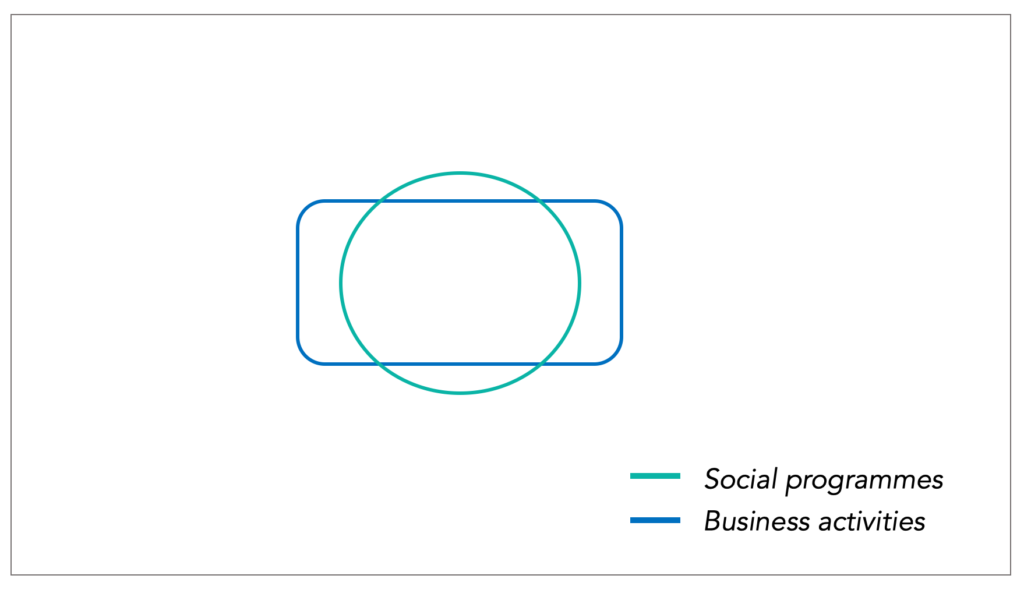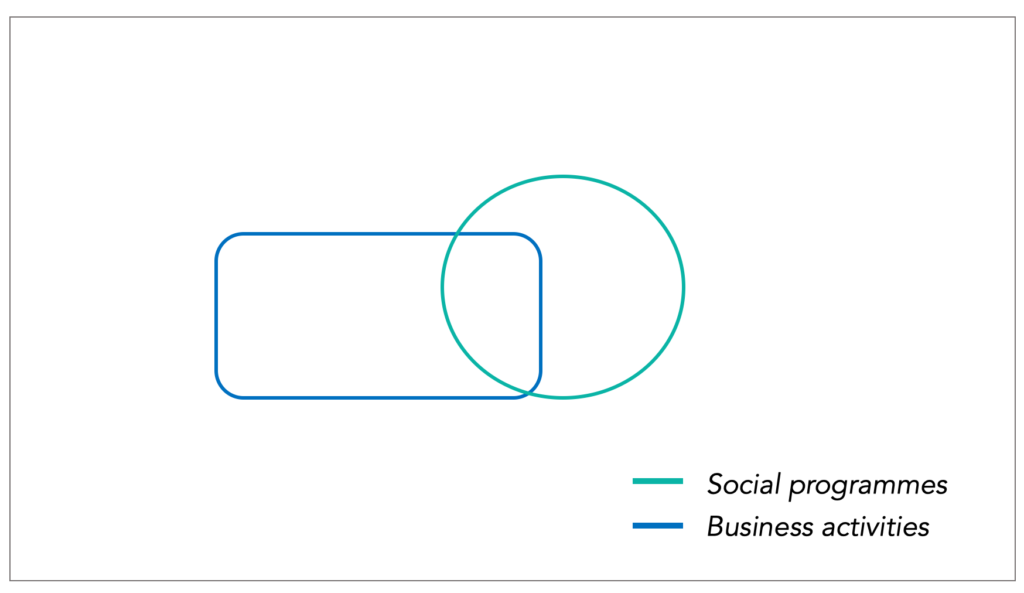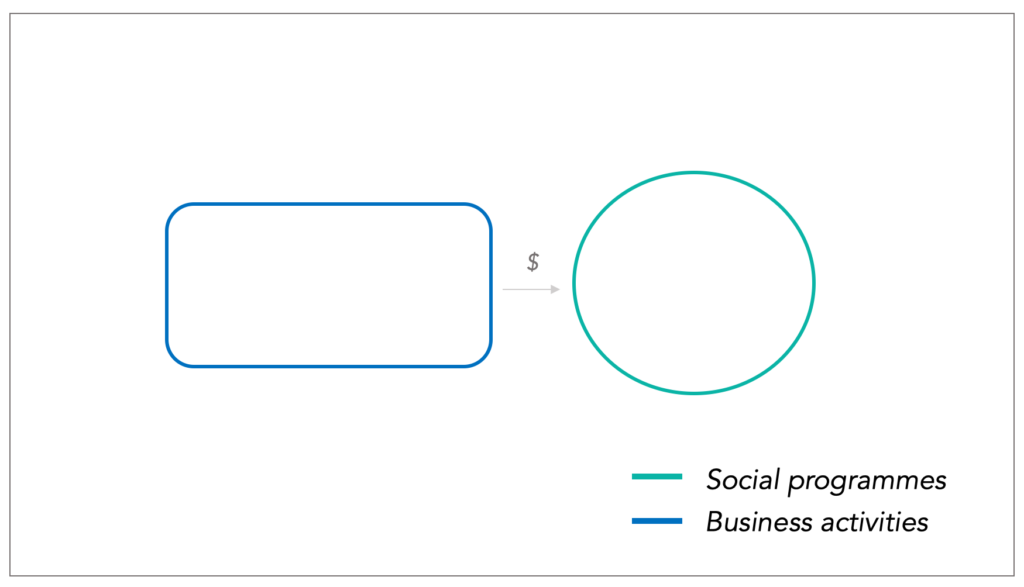
Organizational models for social enterprises
社会企业的组织模式
Embedded, separated and integrated models
嵌入式、分离式和集成式模型
The emergence of social enterprises and revenue-generating activities in the non-profit sector redefined the way changemakers are now tackling . As a consequence, several organizations started to combine business principles and impact missions in new ways. In this article, we take a look at the 3 main organizational models for social enterprises and help you navigate through them.
社会企业的出现和非营利部门的创收活动重新定义了变革者现在解决社会问题的方式。因此,一些组织开始以新的方式将业务原则和影响任务结合起来。在本文中,我们将了解社会企业的 3 种主要组织模式,并帮助您浏览它们。
What is an organizational model?
什么是组织模式?
Before digging into the topic, let’s make it clear what we consider as “organizational model“. Traditionally, an organizational model is seen as “a system outlining how certain activities are directed in order to achieve the goals of an organization” (Investopedia). It basically describes how the work flows through an organization.
在深入探讨这个话题之前,我们先来明确一下什么是“组织模式”。传统上,组织模型被视为“概述如何指导某些活动以实现组织目标的系统”(Investopedia)。它基本上描述了工作如何在组织中流动。
Now, for for-profit companies, organizational models (or “structures”) define roles, responsibilities, links among departments, as well as the general hierarchy within the firm. Obviously, the chosen structure must align each part of the organization and make sure they all contribute achieving strategic business goals.
现在,对于营利性公司来说,组织模型(或“结构”)定义了角色、职责、部门之间的联系以及公司内的一般层次结构。显然,所选的结构必须使组织的每个部分保持一致,并确保它们都有助于实现战略业务目标。

However, when it comes to social entrepreneurship, it all gets a little bit more complicated. As a matter of fact, apart from creating economic value, social enterprises create social value too. At every stage of their lives, these enterprises need to find a balance between social programmes and business activities.
然而,当谈到社会企业家精神时,一切就变得有点复杂了。事实上,社会企业除了创造经济价值外,也创造社会价值。在其生命的每个阶段,这些企业都需要在社会项目和商业活动之间找到平衡。
Said Malki (2009) was among the first scholars to provide a classification of social enterprises, based on their business/program integration. He identified three main organizational models: embedded, integrated and separated.
Said Malki(2009)是最早根据业务/项目整合对社会企业进行分类的学者之一。他确定了三种主要的组织模式:嵌入型、集成型和分离型。
Let’s dive and break down each one of them in the following sections.
让我们在以下部分中深入研究并分解其中的每一个。
Embedded model 嵌入式模型
In the embedded model, business activities have a direct, positive impact towards achieving the organization’s social impact mission. Because of that, entrepreneurial activities are core to the mission.
在嵌入式模型中,业务活动对实现组织的社会影响使命具有直接、积极的影响。因此,创业活动是使命的核心。
What happens is that social enterprises create and sell products/services to directly solve the social problem tackled. In other words, their social and business programs are one and the same. Specialisterne or Sanergy are just couple examples of companies using an embedded model, in which financial benefits and social impact are achieved simultaneously.
所发生的情况是,社会企业创造和销售产品/服务来直接解决所解决的社会问题。换句话说,他们的社交和商业计划是一回事。 Specialisterne 或 Sanergy 只是使用嵌入式模型的公司的几个例子,在这种模型中,经济效益和社会影响是同时实现的。

Integrated model 综合模型
A slightly different approach could be the integrated model. Here, social and business programs are connected, but aren’t exactly the same thing.
集成模型可能是一种略有不同的方法。在这里,社交和商业项目是相互联系的,但并不完全相同。
On one hand, these programs share assets, costs, expertise, even personnel. So, there is a crossover among the two categories. Yet, even though the products/services sold relate (at least to a certain extent) to the organization’s mission, they do not directly solve the social problem addressed by the organization. This is because enterprise activities act as funding mechanism: they help the organization generate funds necessary to keep the mission programs up and running.
一方面,这些项目共享资产、成本、专业知识,甚至人员。因此,这两个类别之间存在交叉。然而,即使销售的产品/服务与组织的使命相关(至少在一定程度上),它们并不能直接解决组织所解决的社会问题。这是因为企业活动充当融资机制:它们帮助组织筹集维持任务计划正常运行所需的资金。

This is usually the case of companies such as Aravind Eye Care Hospital. As a matter of fact, each enterprise serves two diverse targets and charges a premium to one segment in order to subsidize the other.
阿拉文眼科护理医院等公司通常就是这种情况。事实上,每个企业服务于两个不同的目标,并对一个细分市场收取溢价,以补贴另一个细分市场。
Separated model 分离型
Last, but not least: the separated (or external) model. In a separated model, social programs and business activities are distinct, with little or no connection with each other.
最后但并非最不重要的一点是:分离(或外部)模型。在分离的模型中,社会项目和商业活动是截然不同的,彼此之间很少或没有联系。
In fact, enterprise activities are unrelated to the mission, being usually organized as profit centers or separated entities (subsidiaries) of the organization. Like in integrated models, business activities are a funding mechanism, but do not share costs or assets with social programs. This is why we said they are not connected one another.
事实上,企业活动与使命无关,通常被组织为利润中心或组织的独立实体(子公司)。与综合模型一样,商业活动是一种融资机制,但不与社会项目共享成本或资产。这就是为什么我们说它们彼此没有联系。

Here is a fun fact for you. The luxury company Rolex donates all its profits to its parent company, Wilsdorf Foundation, that supports cultural and social initiatives of all kinds. Technically, this is an example of separated model, with a subsidiary generating funds to further another organization’s social mission. You would have never said that, right?
这是一个有趣的事实。奢侈品公司劳力士将其所有利润捐赠给其母公司威尔斯多夫基金会,该基金会支持各种文化和社会活动。从技术上讲,这是一个分离模式的例子,子公司产生资金来推进另一个组织的社会使命。你绝不会这么说,对吧?
Conclusion 结论
In this article, we started to get a bit more familiar with organizational models for social enterprises. In particular, we focused on embedded, integrated and separated models. As seen, each model has a very diverse degree of connection between their business activities and their social programs.
在本文中,我们开始更加熟悉社会企业的组织模型。我们特别关注嵌入式、集成和分离模型。正如所见,每个模型的商业活动和社会项目之间的联系程度都非常不同。
Even though any of these models could potentially work just fine, it’s important for a social entrepreneur to delve into the implications of each. Feel free to compare organizational models with the business models we discussed in this article. Eventually, this will help you choose the most suitable one for your social enterprise!
尽管这些模型中的任何一个都可能运作良好,但对于社会企业家来说,深入研究每个模型的含义很重要。请随意将组织模型与我们在本文中讨论的业务模型进行比较。最终,这将帮助您选择最适合您的社会企业的!
Did you like this article?
If so, then don’t forget to check out for more at Social Business Design.


